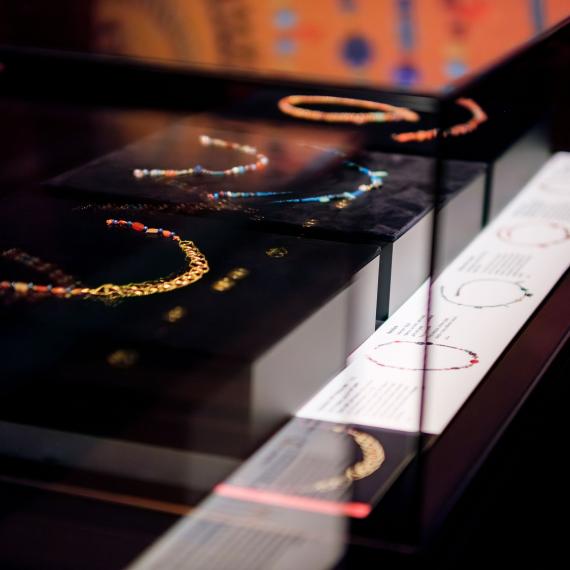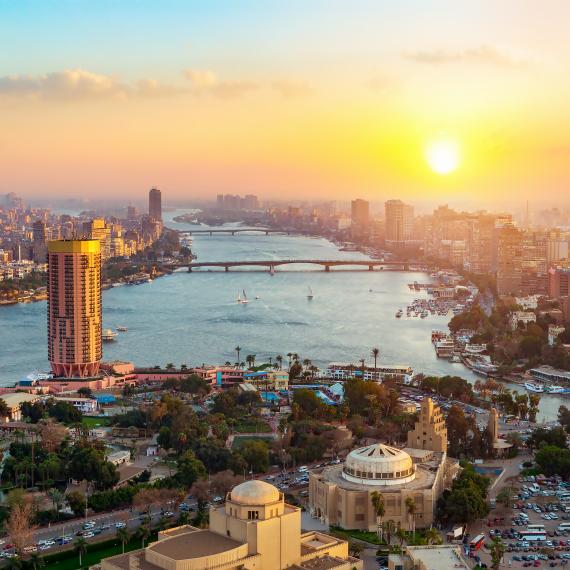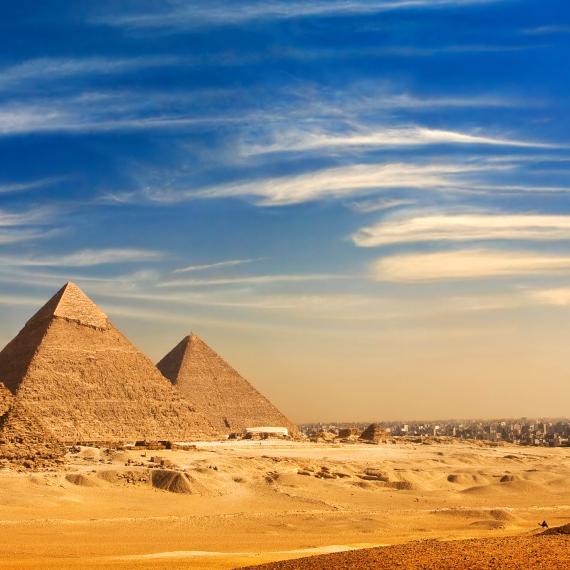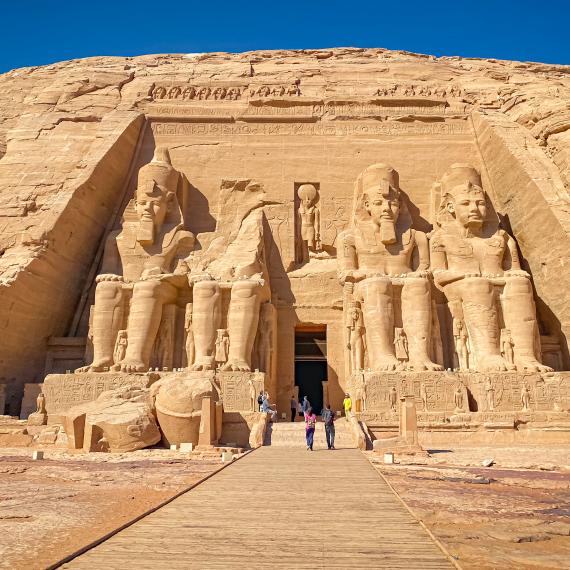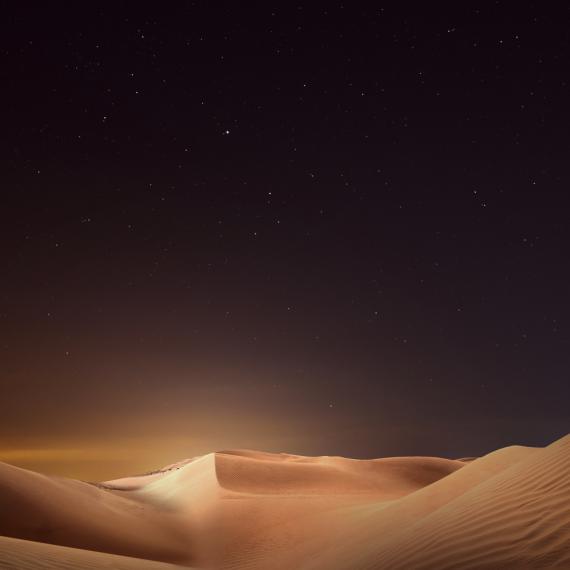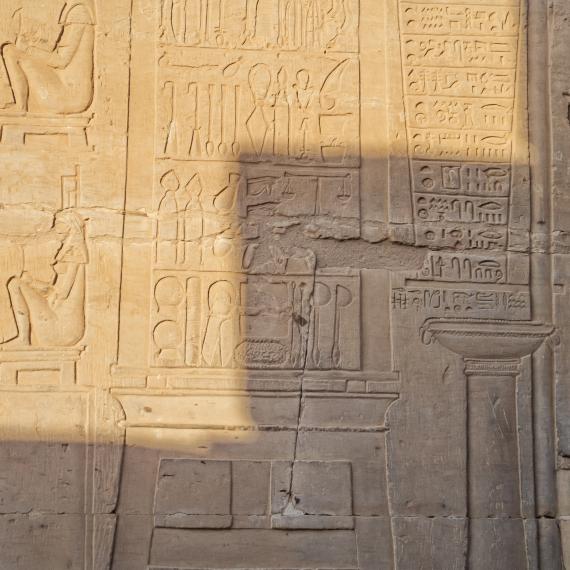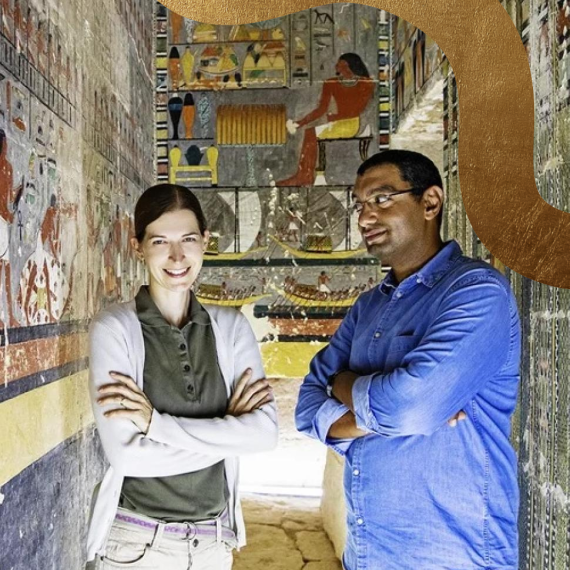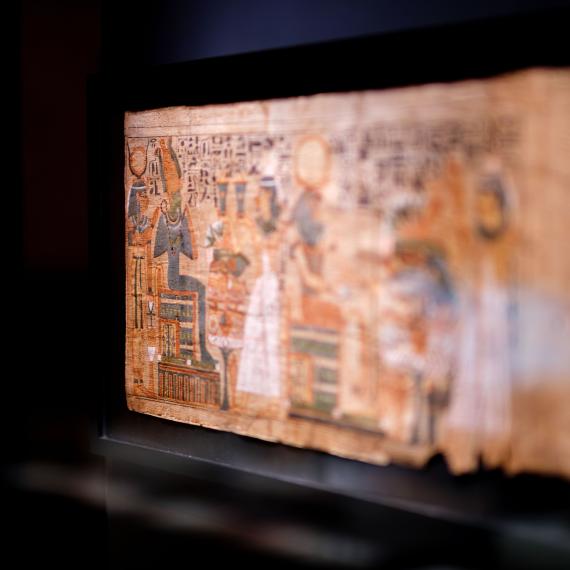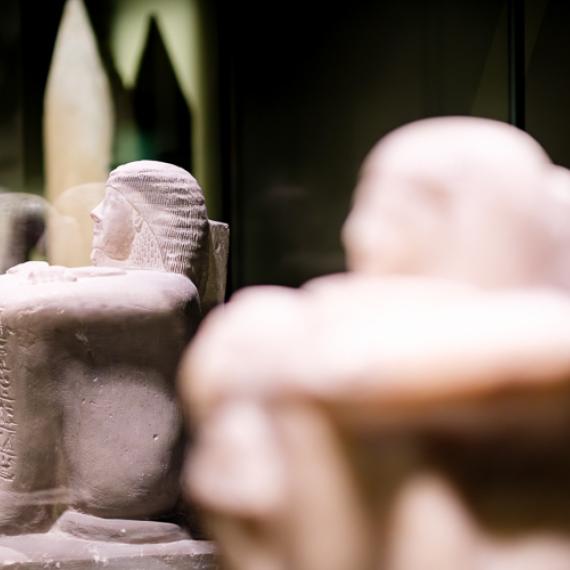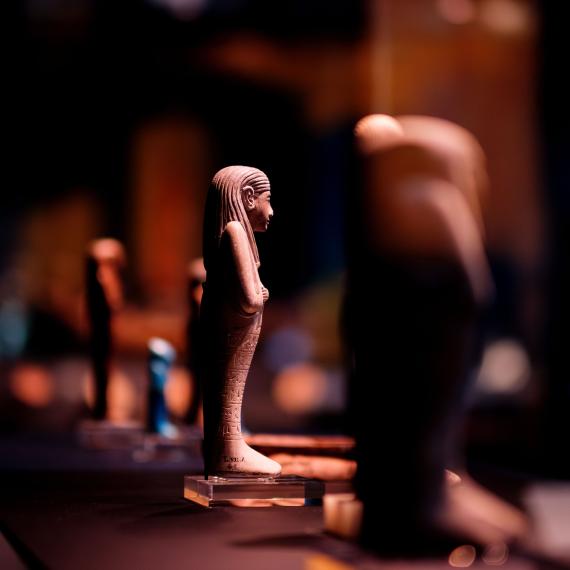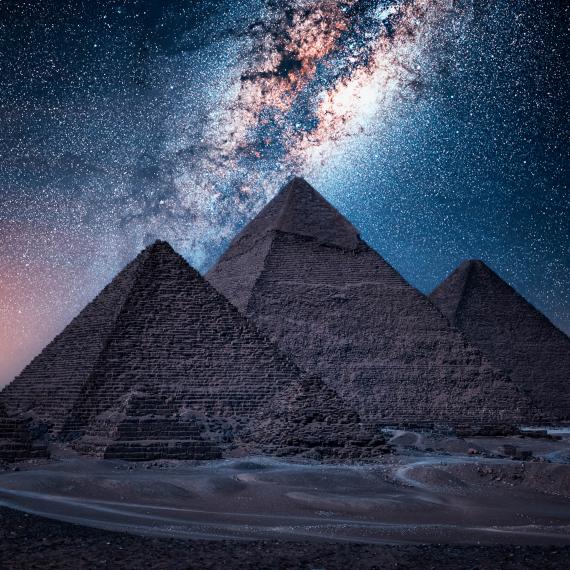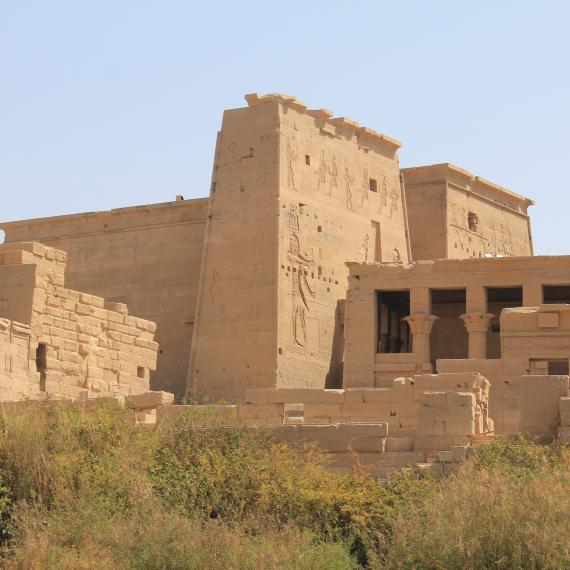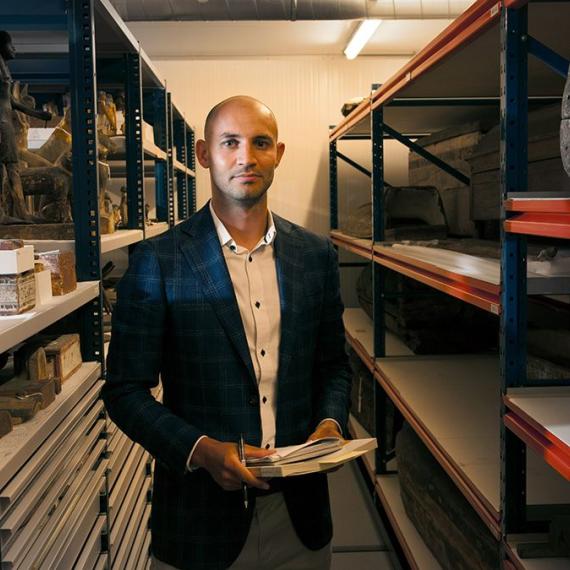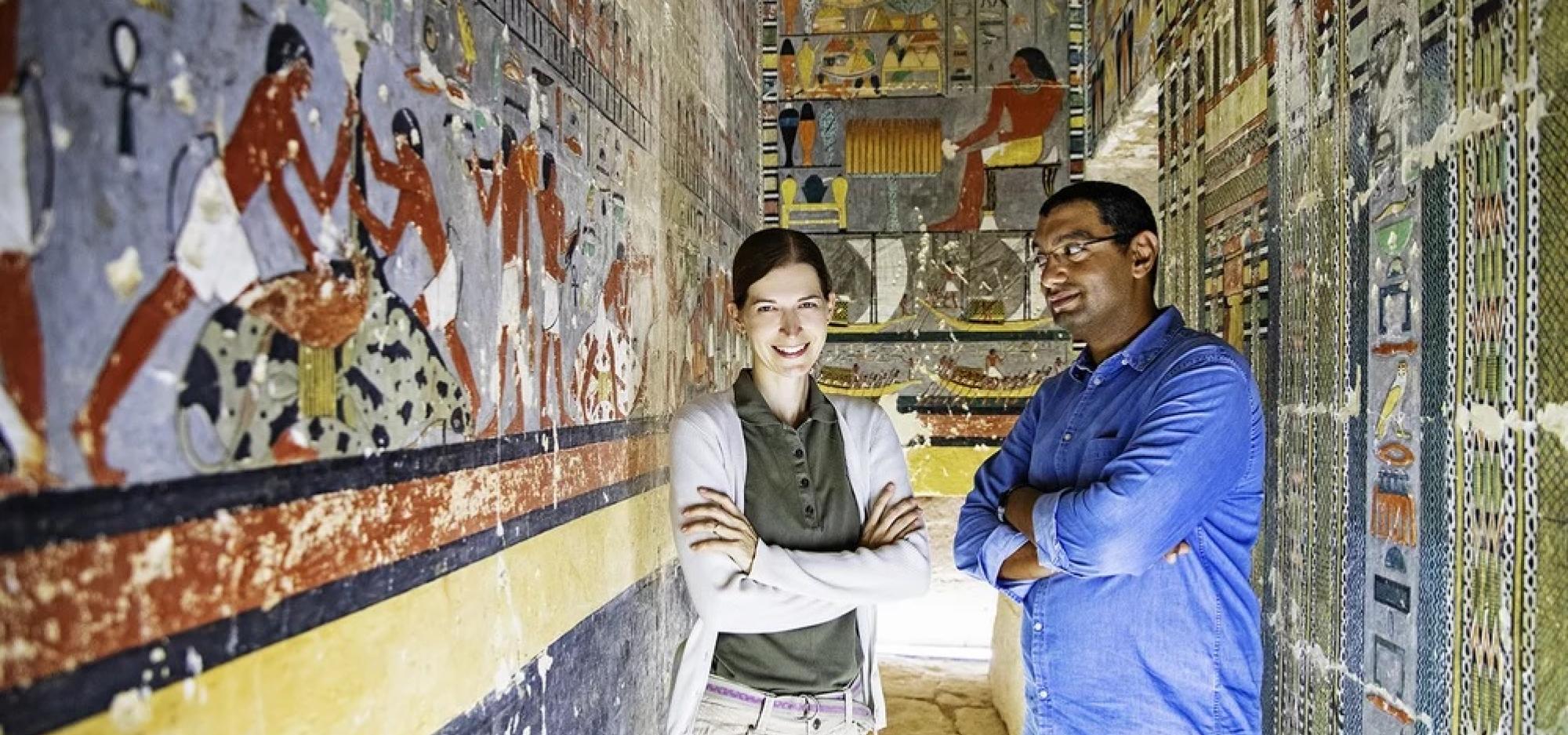
The Tomb of Khuwy (Dr. Hana Vymazalová)
Discover the story of the pharaoh Djedkare, his family and courtiers, and take advantage of the rare opportunity to hear from visiting international Egyptologists Dr. Mohamed Megahed and Dr. Hana Vymazalová of Charles University, Prague.
The most powerful queen in the Old Kingdom was buried next to the pharaoh Djedkare in the largest pyramid ever built for a king’s wife. Near her lies the Crown Prince Isesiankh who did not live long enough to succeed his father on Egypt’s throne.
Taking you to their archaeological site at south Saqqara, Egypt, the two Egyptologists will introduce the Djedkare Project and share its most important results. They will share the stories of this ancient Dynasty 5 pharaoh, his queen and their courtiers by showing you the discoveries made by their mission; discoveries that have rewritten the history of Old Kingdom Egypt!
The discovery of the tomb of the courtier Khuwy by the Djedkare Project was ranked by Archaeology Magazine as one of the 10 most significant archaeological discoveries of 2019. The tomb is stunningly beautiful and clearly indicates the high status of its owner. The artists who decorated this tomb were among the first to use an innovative approach to express the changing tendencies and interpretations of funerary beliefs.
This talk was in English and the session was facilitated by Heather Tunmore (Honorary Associate of the WA Museum).
Listen to Dr. Mohamed Megahed's talk here.
Meet the Speaker
Dr. Hana Vymazalová is an Associate Professor of Egyptology at the Faculty of Arts of the Charles University. Since 2006 she participates in the Czech archaeological excavation in Abusir, and since 2015 she is a member of the Egyptian mission exploring the royal cemetery of pharaoh Djedkare at south Saqqara (mid 3rd millennium BCE). Besides the field work, she focuses on the economy of the Old Kingdom Egypt and the earliest administrative archives. She also studies ancient Egyptian science, especially mathematics and medicine.
-
Episode transcript
Tarryn Fisher:
Hello. Good afternoon. Evening everybody. Welcome to the WA Museum Boola Bardip and to our fantastic talk. It's so wonderful to see so many of you here. So, thank you very much for coming and giving up your evening. My name is Tarryn. If you need anything, you're welcome to come and say hello. I'm going to introduce our first speaker of the evening, Moya Smith, who is our curator of anthropology here at the WA Museum. And she's going to welcome you and give you an acknowledgment of country. So on to you Moya.
Moya Smith:
Hello. And again, welcome to Boola Bardip - Many Stories. As we gather here to hear, tonight to hear stories of ancient cultures thousands of kilometers away, I'd like to acknowledge that we're meeting in Wadjuk Boodja, the traditional lands of the Nyoongar people. I'd also like to acknowledge their ongoing connection with their ancestral lands, waters and skies.
I'm now going to pass you over to Heather Tunmore, one of our honorary associates who will keep on welcoming you.
Heather Tunmore:
Thank you, Moya. Well, yes, I would like to welcome you here and introduce you to Hana Vymazalová. Dr. Hana from Prague, from Charles University in Prague, who has been doing some amazing work in Egypt. And she's been going around schools, talking to students, and now she's here talking to her. So please welcome Hana.
[applause]
Dr Hana Vymazalová:
So good evening, everybody. I hope you can hear me well, you can see well on the screens everything. Okay, so let us start. We will have two talks tonight. The first one by me will be introducing to you our site in Egypt, where we excavate. And what do we do there in the long term? And then the second talk, which will be given by Mohamed, by my colleague, will show to you one of our nicest discovery that is very attractive to see. And he will try to explain how do we work there? What does it mean to find such a thing and what kind of responsibility it is to work there.
So let us start right away. Where do we work in Egypt? Of course, that's a very big country. Currently, there are more than 250 foreign and Egyptian archeological missions working all over Egypt. So, where do we concentrate? It's in the area of the ancient capital, Memphis or Men-nefer, if you would like. So, this is the area where the elite of the first Egyptian state left and how the kings of Egypt rule. And it's also a place which even in the later periods when the capital itself moved to Thebes, to the southern part of the country, the place still stayed an administrative center.
So, all over the historical periods of ancient Egypt, which were more than 3000 years, we had here a lot of very important people living and being buried in the desert. Now, you can see, of course, and many of you probably know this (I cannot use the pointer sorry) that Egypt is surrounded by desert and is just one single valley of the Nile River. And the people used to live on the banks of the Nile. So, where they lived in the antiquity, they still live today. So, we do not really have many cities or villages attested in archeological excavations because that's where the people still live today. So, what we mostly have from ancient Egypt are tombs. And tombs were built for eternity because Egyptians believed that they would continue living in the afterlife in the same way that they would be living in this life.
If we talk about the Memphite cemetery. So, the cemeteries of the ancient Memphis capital, it's still a very long area. This is just a part of it. You can see here in this in this part is the Abusir cemetery. You actually have in the exhibition here a model of the Abusir cemetery. That's very nice coincidence actually, we didn't know that.
We have here the central part of Saqqara, where the oldest pyramid built in Egypt is situated at the Djoser Step Pyramid in Saqqara. And then we have here at the southern part of Saqqara, and that's where we are actually working with Mohammed. And we are working in a cemetery where there is one of the very important pyramids of the old kingdom, Djedkare’s pyramid. Djedkare was the ruler of the late fifth Dynasty. So, at the end of the fifth dynasty, which is something like 2400, 2500 BCE, so it's a very long ago. Yeah, it's a really like the peak or the middle of the earliest Egyptian state, the old kingdom that we are talking about here. And the cemetery is very important for several reasons.
Now, the pharaohs who ruled before Djedkare, they were buried somewhere else. They were buried in Abusir. So that's like about four or five kilometers north. And Djedkare for some reason decided to be buried elsewhere. We do not know exactly why. There have been a lot of theories and hypotheses about that, whether he wanted to distance himself from the earlier Kings or whether he did not have a suitable place in Abusir anymore. But actually, the answer is much more simple because Djedkare’s pyramid is situated exactly to the west of where the ancient temple of Ptah used to be located. So, Djedkare actually strengthened his legitimacy to the Egyptian throne by putting himself to a visual connection from one of the most important divine temples of the time, the Temple of Ptah at Memphis. So that was no coincidence that he actually placed his pyramid over here. And later there are other pyramid complexes developing around him. That’s sixth dynasty, that's after Djedkare. But he was the first king who decided to build his pyramid in this area.
Now, we are not the first mission that excavated this place. It was actually excavated in the 1946 by Egyptian archeologist Abdul Selim Hassan. And in 1952, another season, one month long by Ahmed Fakhry, another Egyptian archeologist. They are both very well-known figures in Egyptian archeology, and they had something like called Pyramid Studies Project. So, they were studying the pyramids of ancient kings. But both of them unfortunately died too early and they never finished the work in Djedkare’s pyramid complex and they never also published it.
So, we know they excavated the place, but we have no information about what they did, what they found, where they found things. We don't have any records. And of course, for Egyptologists, information is what matters. Like what we are trying to do is not discoveries. We are trying to gain information and interpret them to understand better the ancient history. So, this situation for us it’s not ideal. And actually, if you think about like, okay, these people worked there 70 years ago and until now we really knew nothing. We did not even have a precise plan of the pyramid complex of King Djedkare.
The only things we have are these few photographs. We have about maybe 20 of them or 30 of them, which are kept today in museums, in archives. Half of them in the Oriental Institute in Chicago, and another part in a university in Milano, in Europe. So, this is all we have. We don't have any texts, any records, any descriptions. We only have a few photographs. But still, they are very valuable of us, for us, sorry. And so, what happened? What we actually are doing on this site, you know, it was excavated before. So, for many archeologists, many Egyptologists, it's not attractive enough. So, nobody was willing actually to go back and say, okay, this work has been started, but this has never been finished, so let us do something about it.
So that's what Mohamed decided to do, you know. In 2010, so something like 13 years ago now, he said, okay, you know, it's something very important. This monument has never been really documented. Let us go back and do what the Egyptian missions owe to science. And he started a project, Djedkare’s Pyramids Complex Project. The main aim of it was to get the information. Again, I’m repeating - no new discoveries. We thought we would not find anything new. We just wanted to clean the temple, clean the pyramids, protect it and document as much as we can so that we can actually start working on understanding this monument and its place in history. Because as you will, you will see by yourself, it's a very special place.
So, the first step is Djedkare’s Pyramid itself. Yeah. I mean, you probably have seen Khufu's Pyramid in Giza or Khafre’s Pyramid in Giza, that's the largest ones. And they are in much better condition. But not every pyramid in Egypt is in that state. This is how it looks today. You can see that it used to have casing, which was since the antiquity taken away. So today it looks a little bit, you know, not so pretty. And of course, also in the inside, it's very damaged because Egyptians had used materials. You know. Here there used to be a burial chamber which was built a very nice white limestone blocks. But white limestone blocks was an expensive building material.
So, after this pyramid was abandoned, for instance, a thousand years later. So, we are talking something like, you know, late second millennium BCE still. Other people came and they would say, okay, you know, here is this really nice material. Let's just take it away. It's easier than to go to the quarries on the other side of the river and bring it from there. So, they would dismantle the room, and this is the result. So, when we came to work here, we faced the situation that there are actually, you know, big pieces of walls missing and where the walls are missing, the stones from the pyramid itself, they kept falling down. So, we felt actually every plane coming over the pyramid or every helicopter there is a military base just south of the sites. You have a lot of helicopters going there. And we would actually be really careful about where we would stand inside the burial chamber because you wouldn't really want anything to fall on your head.
So, the first thing is preserve and save the monument. Now, what we did first, however, before we started consolidation works, we documented the situation because if you don't have the chamber there, actually it's very interesting for you because you see behind the walls. You see the builder’s work. You see the methods of the ancient builders, how they actually constructed the pyramids. So, this is like an open book for an Egyptologist to understand the ancient methods.
And we did 3D scanning. We were one of the first missions who used that in Egypt in 2015. And this is the result. You can do different sections, you can do sections in different parts and it can show you, actually can help you draw a ground plan of the thing. Or it can show, you'll see the sections through which, for instance, here you see a small part of the wall missing but on the scan under on the section, you can actually see how much of the pyramid itself has already fallen down and crumbled and it's missing from the core. So, the situation was really quite dangerous. And we spent about five years doing consolidation of the pyramid to preserve it for the future. So now it's very safe. But of course, it's no more an open textbook of ancient builders’ methods.
Now, the next stage was documenting the and mapping of the Temple of the King. As you can see on this photograph, the whole temple is completely dismantled. Yeah. There is almost no walls standing, only small parts. But most of the temple is actually gone. But if you clean the sand that is covering the rest, you actually find out that it's one of the best-preserved pyramid complexes in Saqqara. It does not look like that, right? But it really is. You have a lot of the parts have actually the pavement preserved. But you do not have the pavement, you have the foundation that was underneath the pavement. And on these blocks you can actually recognize where the walls used to be, where entrances used to be, where there was door leaves, you know, set in and so on. So, all these tiny little details, if you clean it properly and you look carefully, you can actually reconstruct how the temple looked like in the ancient times.
For instance, this is a view of the intimate part of the temple you see here, the foundation blocks, which are the rougher bonds. And then on top of them are the floor blocks. So even though we have very few of the floor blocks, we can still reconstruct the layout of this temple. When we finished the work, again, we need to protect it. So, what we do is we cover. We back, fill it, we cover it with sand, because that's the best way how to protect the stone today from the aggressive environment above us, around us.
Now, this used to be on the, your left side, a plan, which was published in the 1960s and 1970s by two Italian architects, and they could not excavate the place. So, they actually drew many parts of this plan, just, you know, from their imagination and comparing to other pyramid complexes. And on the other side, you can see the result of our ten years long work. It took us really ten years to map the temple. But of course, this is just a very simplified schematic view. We really mapped every single stone that is on the, in the temple preserved.
Now another story is the relief decoration from the king's pyramid complex. You know, until our mission started working that 13 years ago, everybody knew that somewhere in the storerooms of Egyptian Antiquities Service there are some fragments of reliefs from Djedkare’s pyramid complex. A few of them were mentioned in publication, but none of them were actually published. And it took a long detective work to actually find these reliefs. Again, we just had a few figures with photographs from the earlier excavators, but it actually took about like three or four years to locate them all over Egypt in different storerooms. And it took about ten years to bring them back to the site and to study them properly.
And some of them are really beautiful. You can see here, for instance, the king who is sitting on a throne and the goddesses are giving him life. This is a very typical scene in ancient Egyptian art, which is showing the king being sort of accepted by the gods and being helped during his rule. Some of the scenes are better preserved. But you saw the temple, how completely damaged it was in the antiquity. And so, most of the fragments we have are actually very small fragments of reliefs, which, however, if you're patient enough, you can put together. So, you have another scene of the same kind here, for instance, but in much more fragmented condition.
And I just want to show you a detail of this. You know, it's a beautiful piece of art. It's like really amazing reliefs. So, you not only study the iconographic program within the temple, but you also can study the art of the Egyptians. And how did they carve the relief? How did they paint it? You look at the details. You know, the designs they have there.
Now, chapter two is the queen of Djedkare. So, it took us about ten years to document and map the temple and to protect the pyramid itself. And just next to his larger pyramid, you can see the smaller, you know, mound. Smaller pyramid that belonged to a queen. And it was known, again since the time of Ahmed Fakhry's excavations, since 1952, when he excavated the temple on the eastern side of the pyramid. And it was noticed that actually this pyramid complex of a queen is very unusual. Like, it was not typical at all for that period, yeah. First, it's the largest pyramid that was built for a queen in the old kingdom in the third millennium, B.C. So, this one is the largest. And it's not just largest is like twice as big as the other ones. So it's a really large pyramid. And the temple itself, it actually combines elements which were usually in queens tombs, but also in the royal complexes. So, it somehow combines elements that were associated with kingship, which a queen is not supposed to have in her monument. So, everybody knew since Ahmed excavation that this queen was like, somehow special. But how special?
There are a lot of speculations. Now Fakhry did not find any remains of her name or titles or anything like that. So, her identity was unknown for 70 years. And there was speculation about could she be, you know, Djedkare’s mother who helped him to the throne, could she be the mother of his successor Unas? Could she be actually a ruler or a regent for Unas? Nobody really knew. So, there were a lot of hypotheses expressed in the scientific publications. But actually, everybody agreed that without further excavation, without further evidence, we cannot really say anything more and we can just argue about everything.
So, what we did in 2018, we were still mapping actually the king's complex and the so-called northern portico of it, and we wanted to see what is in this area. And that was the only area that Abdul Selim Hassan and Ahmed Fakhry never touched. So, this is an area where we had the original sand that accumulated over the four and a half thousand years since the pyramids were built. That was very exciting for us of course.
What we found there were a lot of secondary burials. Secondary burials they belonged to the people who lived many, many, many years, even millennia after Djedkare and his queen but they still wanted to be buried in their vicinity. In the vicinity of these monuments. They didn't even remember the names of the king and the queen anymore, but they really wanted to be buried there.
There were people who lived in the villages just in front of the Saqqara monuments, and so we have a lot of material that is actually very valuable because it was not recorded in earlier archeological works in Egypt. You know, when other pyramid complexes have excavated, people just cared about the old kingdom, about the pyramids themselves. But what we collected is a lot of a lot of material about the later history of the monument. So, we not only monitor the later history and the historical development, also development of the environment. But we also have evidence about burial customs that cover more than 2000 years of Egyptian history, and that belong to poor people.
So that's the people who would never have the means to build their tombs and to decorate them and to write inscriptions about their lives. They would not even be able to read and write in their life. So, we are actually now studying their bones, mostly partly preserved. Yeah. And we are the first ones who can start telling their stories in their lives because the bones do tell the story. So, these people actually get the voice through our work for the first time.
There are just some objects that we find associated with them. It's actually very interesting. Most of these most of these burials, they have no objects with them. They are really the lowest class of population. And when we find amulets like this, you can notice those who understand some of them are associated especially with the women and children protection. And actually, we usually find these finds with the children or young women. So other burials are usually without any objects. Children and women sometime have objects like this.
Now this. So, what we actually got when we got to the ground level after removing six meters of sand with the burials. And what we found was, this is the north portico of the king and just opposite to it is actually the entrance to the monument of the queen. So, there was actually another part of her temple on the south side. And the two temples had an entrance just in front of each other. They were just so the queen actually was facing the king when offerings were being brought to her. That's a very interesting for us.
This is the portico itself. You can again see that the walls are not there anymore, but you can see the outlines of them, right? It's very easy to see them. And we found this really beautiful column in there, which is also special because queens in the old kingdom did not have granite columns. Never. That's a king's thing.
You can notice also these tiny little scratched basins in the pavement and other basins on the side. These belong to later periods of history when the pyramid was still being used for funerary cult, but private individuals would be coming there and putting their own offerings or like trying to get a little bit of the protection from the queen and from her offerings and from her temple for themselves. So, these are like, like we had the secondary burials from the later periods. These are kind of, you know, as people associating themselves with the queen. Still, when the pyramid complex was standing and being used for her cult. So, it's a very interesting for us.
What we also found, what Fakhry did not, was the name of the Queen, and this is one of our actually biggest finds. We found a complete inscription on the column that I mentioned a while ago, but we also found partly preserved inscriptions on other reliefs. And it gives us information who she was. Her name was Setibhor. It is a very unusual name in the old kingdom, and she is the only one who has this name. And she was actually wife of Djedkare.
So, like this we were able to answer one question. So, who was the owner of this very special monument? Yeah. We are able to say now, okay, she must have been the one who gave the right for the throne of Egypt to Djedkare. So, he apparently, you know, had some difficulties to get the throne for himself. And she was the one who helped him. But we have many more questions. So, in Egyptology, once you answer one question, you have 100 more questions that you cannot answer.
So, we still do not know who she was, where she came from. She probably was related to the kings who were buried in Abusir, who ruled before Djedkare, but we cannot prove any of that because it's never mentioned in the texts. So, this is really a nice thing about Egyptology or archeology in general. You try to put together the tiny pieces of evidence, but you never actually get a complete picture. So, it leaves you a lot of space for future work. And, you know, maybe in ten years, in 20 years, we will get a new small piece of information that will combine with this what we found, and we will be able to answer another question.
This is just another view on the portico. We actually found out in the year 2020, just when the COVID was starting, we had to cut our excavation short because of the closing of the airports and we actually found, you know, that the portico blocks from the portico had just fallen in front of the temple during an earthquake, which happened in the early second millennium before Christ already. So actually, when the people in the new kingdom came and take away, you know, old building material, this temple was already very damaged by earthquakes. So, this is a very interesting piece of evidence.
And we found here several blocks that belong to the decoration of the portico. And you can see here some special details, yeah? You can see in the top the solar disk with two cobras and with wings. This is a royal symbol. So again, like the columns, like the other features in the temple, this is not supposed to be in a queen's pyramid complex. But what is interesting is that she is the first one for whom we have it attested from queens. But later in the 6th dynasty, so the queens who came after her, they use it.
So, it seems that Setibhor, the owner of this pyramid, she actually set up a trend, yeah? And then the later queens sort of followed the inspiration that she provided to them. And we also have other, I'm not sure if you can see it on these screens, I hope you can, here she was sitting, she was sitting here or standing here. We don't have her figure, but in front of her, a female offering bearers. And on the neighboring wall, which is the other picture, there are male offering bearers bringing her offerings. And they are actually coming from the direction of the king's temple. So, this shows us indirectly that the offerings for the queen were actually provided by the king. So, there was like not an architectural connection, but there was economic and culture, cultic connection between the two of them. We also found some more architectural features. So, we are now actually putting together how this part of the queen's temple looked like using, you know, many, many, many fragments of relief decoration and architectural features.
Now, in 2021, we decided to have a look inside her pyramid. And this is something that has never been done in modern time. Now, Ahmed Fakhry actually mentioned in one of his other books that he started the work there and, that it was so difficult that he did not manage to finish and he was planning to come back another time and finish the work, but he never came back.
So, we did it after him and it was a very difficult work. I agree with Fakhry. It took us a lot of effort and it was sort of, you know, very tricky and dangerous at some moments. But this is the view of the inside of the chamber, in the pyramid of Queen Setibhor, how it looked when we cleaned it. And the same like in Djedkare, you see, it was completely dismantled in the ancient times. In this case, they even removed the roof itself. So, the pyramid is actually open to the sky.
So, it was a very nice space, actually. And again, we could study how the whole thing was built. And here you can, for instance, see these are the back walls that originally had the limestone casing around it and then the small stones on the top - that's the core of the pyramid. So, you can actually see from what kind of material these pyramids in the late 5th dynasty were built. It was no more the very large blocks like what you see in Khufu. It was much smaller, you know, material and blocks and even chips of limestone that just filled in the space around the chamber.
Now, you can actually notice here at this little detail, this is the end of the access corridor through which you come into the, into the burial chamber. And you see the strange shape of the blocks here. They are not really so rectangular. They're very special. These blocks are reused. So not only that, in later periods, other Egyptian generations came and dismantle the queens complex, dismantle the queens chamber, and actually took away the building material but she herself reused some blocks in her own pyramid. So, this is something we call cavetto cornice, and it's usually located on the top of the wall somewhere, maybe in the portico or above wall of the temple or somewhere else. It does not belong here to this position. So, she chose, you know, to use these blocks which were of red granite that were intended to be somewhere else, and she just brought them here and used it for her. So, you know, constant recycling since the old kingdom until modern time actually.
Now, even though we don't have the chamber there, we had something different. We had actually outlines on the back walls. You see the red line over that. The red line was drawn by the ancient builders who were building the pyramid. They actually marked the place where the casing is supposed to be placed before it was placed. And now the casing is away again. But thanks to these marks, we actually could make quite a precise plan of the substructure. And you can notice the substructure if you see it. There is like the burial chamber here. That's the larger we have, even the position of the sarcophagus, because that outlines also on the remaining floor blocks. And then there is a kind of Eastern room to the east of the pyramid. And like with the wing solar disk, this is a feature that Setibhor is the first queen who has this layout of the substructure of the pyramid, of the underground part of the pyramid. So, again, like with the decoration and the reliefs, she actually set up, you know, a trend that was followed by later queens of the sixth dynasty.
As you can see here, this is a neighboring cemetery of Pepi I, which is two generations later. And it has many, many pyramids of queens from the sixth dynasty. And you can see here exactly the same kind of design, you know, with one larger burial chamber in the west and one smaller chamber in the east. So, Setibhor actually is the one who started this trend. Again, very important queen.
We did also 3-D documentation, like with the king. So, you can see some of our results here. And now, now let us still have a look around. So, if we have a look at the satellite image of the cemetery, we already saw the kings pyramid complex and his temple. The queen is here and around you can see a whole cemetery of other people. And that was never excavated. So, Abdul Salam Hassan and Ahmed Fakhry, they just focused on the royal monuments. But around you see all those heaps and depressions and little hills in the desert - that's tombs. They are everywhere. Yeah, everything there is a tomb and nobody ever explored them. Now, why, you know. If you think about Djedkare’s time, Djedkare actually was one of the longest ruling kings of the fifth dynasty.
He was on the throne of Egypt maybe for 40 years. So, a lot of things happened in his reign. And we can date to his reign because he ruled so long. And we know a lot of his people already. We know several of his viziers. So that would be like the prime ministers of the ancient Egyptian state, and they were buried elsewhere. They were buried near the Djoser Pyramid; they were buried in Giza; they were buried in other parts of the Memphite cemeteries. So, you know, an early time, earlier archeologist, they probably thought like, okay, nobody important can be around here. Like, you know, why would we even excavate there? And we did and we were actually rewarded.
So, what I was telling you about now, that was happening really over more than ten years. We did ten years of very detailed documentation of Djedkare’s pyramid complex and Setibhor’s pyramid complex. And now we started excavating.
This is how it looks when you come to the tomb, you can more or less see an outline underneath the sand. Sometimes when it rains, it's more clear, sometimes when it doesn't rain, it's not so clear. You see a depression. So, you would think, okay, there might be a chapel there or something or a room. You see some like, you know, higher places. That's where you would expect a wall. And then, of course, you base your research on what you know from other cemeteries. So, for instance, we know from cemetery in Abusir, where we also excavate that these storms are usually very, very damaged. You can hardly see the outline of them. Usually, no finds are found there and so on.
So, when we start cleaning, we actually found that this tomb, which belonged actually to the son of Djedkare, but we didn't know that at the beginning, it was a very large tomb and it was very unusual. So, this is just one of its corners. You can see actually how it's nicely located just in front of Setibhor’s pyramid, yeah. So, there is already a relationship indicated by the location of the tomb. And you can maybe notice that some of the blocks here, especially, they are very large. These are blocks of white limestone which were used to case the tomb from the outside. And of course, this would be the first thing that the ancient stone robbers would be taking away. That's what they took away from the queen and from the king. In this tomb we have a few of the blocks preserved, especially the bottom part, but not the upper part of the tomb that was really dismantled. So, the tomb was very damaged.
This is a view of its portico. That's actually the entrance to the to the above ground part of the tomb. And you again see how dismantled it is. This would be the blocks that would still, you know, have some relief decoration. But we don't have reliefs here because actually this part of the tomb was never finished. We have the preliminary drawings that the artist just sketched on the walls, and then they were supposed to be carved and painted. And that never happened because owner of this tomb died too early.
We would have two pillars here, as you can see. And then you enter the tomb. And we found here, we found a number of fragments with an inscription that would be actually the lintel above the tomb entrance. And you see the strange color of the stone. Does it look like red granite? Yeah. It's, it's limestone. It's limestone. Like in the queen we saw she was the one who could use the red granite even though she was not supposed to really, no. But here, the non-royal people or people who were not really kings, they actually used limestone and painted it to imitate granite. So, they pretended that the material is more costly than it actually was.
Now, another part of the tomb has a huge hall with pillars, and this is something not so usual in this period, something that you would actually rather see in the following periods in the sixth dynasty. Again, you can see that the tomb is very badly damaged, very badly affected by the ancient stone robbers. But you can still see the outline of it, and you can see details like in the west wall where we had a little niche. And a little niche reminds us of something we know, for instance, from a very famous tomb in Saqqara, Tomb of Marakkar, which is two or three generations later than this tomb of Isesi-ankh. There is actually a niche with the statue of the owner who is shown coming back from the afterlife, coming back to this world and, you know, coming to actually eat the offerings that are placed on the altar for him. So, our tomb actually had the same feature and its earlier. Yeah, it's not really very common in this period.
There are also other rooms in the eastern part. Some of them had even columns. That's again very unusual in the non-royal tomb. And as you can see, it's quite spacious. Yeah, it's yeah, we found some relief fragments again, even though most of the blocks with the reliefs have been taken away, we found some reliefs. Some of them are unfinished. As I said, some parts the tomb were never finished, but some of them are really nicely carved and even painted, as you can see here.
And this would be like a preliminary drawing or preliminary plan of the tomb with the portico that I mentioned, with the pillared hall, with a niche for the statue on the north side. There are storerooms still there, but they were just used as storerooms.
And then, you know, there is a big question mark in this part. In this part, we found nothing. Here the whole room, whole rooms were completely removed, completely dismantled. And when we are working, of course, you know, we are already thinking, okay, we are still above the ground, but we still have the underground. So where is the entrance? We didn't find the entrance anywhere until now. There is no shaft, there is no tunnel. There is no corridor anywhere. So, we think like, this is really weird. And then you have this, you know, whole quarter of the tomb completely removed. And there is just the yellow sand, which indicates a lot of work, previous works.
So, what you do is, okay, let's have a look there. You know, robbers must have worked there. There is just yellow sand. So, they knew what they were doing. And this is where we found actually the burial chamber. Now, exactly the same like the queen. They removed the roof of the burial chamber. They removed that was above it. And they just removed all the stones that they wanted to remove and damaged the burial chamber like this.
So, this is a really nice example of a very, very monumental tomb and how it can actually look like today. But still, you can, you can see the architecture. And only when we entered into the burial chamber, we actually found the access corridor. The access corridor of us from, from the columned courtyard or from the columned hall. And why we didn't see it was that just above the entrance, there was actually a very large stone which we decided not to move away because we could not really move it anyway. So actually, the entrance into the substructure is still hidden and we could not see it. But why? This is how it looks. You see it, you see it's blocked. It's blocked with stones that were put there after the burial in the old kingdom after this guy died and his mummy was put in his burial chamber. The priests and the builders, they actually filled the corridor with stones to protect the burial.
Now, the robbers are not stupid, you know. Why to? Why to do so much effort to remove all these stones from a very narrow corridor. It's like 1 to 1, you know, 1 to 1 metre. It's really small. So, they just dismantled the tomb and jumped into the chamber from above. It was much easier for them to do that. So, we did the same sort of. We just cleaned from above. And what we found is a very huge sarcophagus. This is just a piece of the sarcophagus because the robbers actually cut away half of it. But it was made from one limestone block. Now, the bottom part of the sarcophagus, that's this part, it's about a metre 60 tall. So, it's about this height, you know, and then you have more than a half a metre thick lid. So, this sarcophagus was over two meters high, which is enormous. It’s gigantic. It really is a perfect indication of a very high social status of owner of this tomb. Until now, we still did not see the name of the owner, by the way.
We also found a few items from his funerary equipment, but really very, very few objects like broken canopic jars that apparently were used to put the internal organs after his mummification. We will still talk about it in the other talk. We have a few other objects. And we found a few relief fragments which would tell us his titles. And this was for the first time our like, okay, exciting moment because there is a title. King's eldest son of his body. What it means. This was the eldest son of Djedkare and Setibhor who was actually the heir to the throne of Egypt, but because his father lived quite long, he somehow did not manage to take the throne over and he died first. That's why his tomb was built in haste, even though it was planned very large, it was never finished. The reliefs were never finished. His name the only found in builder's inscriptions. They are not reliefs you can see. They are just, you know, sketched on the on the blocks from which the tomb was built. And we found them sometimes actually, they look like this. Can you see anything in that? You have a block like this and only if you sit in front of it with the right light at the right moment, you can actually see that there is an inscription with his name. Yeah. So, we knew that his name was Isesi-ankh. Now Isesi, was one of the names of Djedkare himself and Isesi-ankh means Isesi is living. A very nice name for his son.
We also found builders inscriptions on one of the casing blocks and that actually gives us also the titles. And these titles are the same like what we saw on the fragments of the lintel from the entrance. So, this confirmed that actually the relief fragments belong to the tomb itself and not to another tomb. And funny story is that actually the same inscriptions exactly, we found five years earlier in the pyramid complex of Djedkare. When we were mapping the pyramid complex of Djedkare. So, this shows that during the Life of Djedkare, his complex was being built still, so it was still being constructed, Isesi-ankh participated with his own building material in constructing his father's pyramid complex. That's a very nice family connection in architecture.
And this is just the last view of the tomb. You see, it's really massive. It's really, really very large and very complex mastaba for the period. And so, yeah, it belongs to the oldest son of the king and the queen. Thank you for attention.
HT:
Thank you. Had that was fascinating. So much to process, but are there any questions?
Audience member 1:
Thank you very much. Lovely talk. I was under the presumption that it was the upper echelons of society who could read and write and I think you even indicated that at the beginning your talk. Builders’ inscriptions, the builders could write and read? So that makes me, I'm presuming that they were of a high enough education as well as craftsmen that hmm. Do you get what I'm trying to ask?
HV:
Actually, this is an excellent question. Thank you for that very much. These are inscriptions, but we also have a very high number of marks and they would be just one sign. So, for instance, we have marks which are just a star or a cross or a cross in a circle. And these are made by the people or for the people who could not read and write. Yeah, but the inscriptions themselves, they are probably from the organizers of the thing.
We actually cannot really say when and where exactly these inscriptions and marks got on the stones because they somehow monitor the whole, you know, there's a whole process of bringing the building material. So, you would send people to the quarries. They had to be organized and somehow, they, you know, somebody there, the organizer, would have to know where to send the stones. So that's the one place where all these marks and inscriptions could have been put. They could have been put on the stones during the transport of the material, which could have been like really long, across the whole of Egypt sometimes. Or you would be having them at the cemetery where a number of different tombs was being built and constructed at the same time. And they would just, you know, so okay this heap, this is mine, so let's put my name on it.
And very often when we find these builders inscriptions, they are put upside down or 90 degrees reversed. So that shows that the inscriptions were not put in the tomb. They were actually written on the blocks before the blocks was used for the construction. So, it's a lot of information for us. But like we have a really limited knowledge about who exactly and which stage put them on there. Sometimes they have dates, so it's a little bit tricky to also assume that the dates actually refer to the construction itself or to the quarrying of the material or to the, to the transportation of the material. It's really not it's not really possible to say, but it's a very interesting piece of information.
And actually, in many our tombs, they are very, very valuable because when the when the reliefs are dismantled, like in this case, without these builders inscriptions, we would not know the name. We would not know the identity of the person. So, they are really, you know, for us, they are really exciting pieces of material. But, you know, you won't find them in a museum anywhere because they are not pretty.
Audience member 1:
Thank you very much.
Audience member 2:
Hello. Thank you for a really interesting presentation. It's interesting to see yet another instance of a cult developing around a deceased monarch and queen that goes on for centuries, maybe even millennia afterwards. And yet we also see great damage being done in antiquity to this tomb. Did the damage and the robbing of the stone happen at the same time as there was this cult, or did it tend to happen after the cult eventually degenerated?
HV:
After. Definitely after. We actually can date it quite nicely because we have also an inscription of the Son of Ramesses II who was the biggest recycler of building material in the Memphite necropolis. And actually, when Ramesses II was the ruler of Egypt, these monuments were more than a thousand years old and have, as we have seen when in the middle kingdom, which is like six, 600 years after they were built, there was an earthquake which damaged them. So many of the stones, many of the of the pieces of the temples were already just fallen apart on the ground.
So, when Ramesses II came, he just said, okay, you know, there's so many stones here, let's take them away. We have an inscription of his son, who is sometimes considered to be the earliest, the first archeologists in Egypt, because he left inscriptions in many of the pyramids, in many monuments in the Memphite necropolis. And he says, you know, I came here on behalf of my father, Ramesses II, in order to commemorate the name of the king and renew the monument of this king. But what they actually did is they took away all the blocks and then they just, you know, try to sort of, you know, make it look nicer. And we have his inscription on the queen's pyramid. We have a very small fragment of it, but it really attests to the period of the, to the Ramessesite period when the monument was being, like the materials were being reused a lot. Yeah.
And it was already like the cult was discontinued very long before that and the temples were very much damaged. We can however date little bit how long the cults lasted because we have all those, you know, offering tables and other finds. So, it does show us that at least until early middle kingdom, the cult was being continued in one way or another. The temples might have been already partly shut down. The cult might have been very limited by the time comparing to the old kingdom period. But they still existed. They still maintained it. But after some time in the middle kingdom, it discontinued. People started to be buried there already during the middle kingdom. So that is an indication that the cult actually stopped.
So, we can from actually the later periods from all these, you know, tiny little finds, we can actually nicely reconstruct the history of the monument itself.
Audience member 3:
Good evening. Where is this site in relation to the Stepped Pyramid and is there any connection between, between those?
HV:
It is to the south of the Step Pyramid and it's a couple of kilometers. I think it's two or three kilometers to the south of it. And if you want any connection to that, I would say it's just between the Step Pyramid and the Sneferu pyramid in Dahshur. So Djedkare actually put himself really somehow in the middle of this way. So, he associated himself with the earliest pyramid of Djoser, which was a monument of its own at that time, a few hundred years old already, and to the pyramid of Sneferu which were the first real pyramids, like not stepped pyramids, but smooth pyramids built in Egypt. And he's just in between.
And at the same time, he is linked to the temple of the Ptah at Memphis. So, he really chose a very, very symbolic place for his pyramid.
Audience member 4:
So, you know how you said that, in the, that the son of Ramesses II went over there and looted all of the stones. But though in the New Kingdom wasn’t Ramesses basically destroying the whole entire economy, spending all of his, the economy on building projects like Abu Simbel and renovating Karnak Temple? Then why would they have looted if they were, if Egypt was becoming rich and was expanding its empire? And why would the government make an exception of desecrating a royal tomb which is a crime?
HV:
Mhm. Oh, this is really great questions. Thank you for that. Actually, Ramesses II really built massively. He was like the biggest builder in history of Egypt and he not only like reused material from earlier monuments, but he also, for instance, renamed statues of earlier kings. So, he would take a statue which is 500 years old of a king from middle kingdom, and he would put his own name on it. And like that, you know, he somehow appropriated it.
This is in our way, it’s a desecration but in their own way, it was not necessarily so. First, these monuments were already completely damaged, yeah? They were abandoned since millenia. They were very much damaged by earthquakes. So, in a way, he did take care of them. He just somehow reused some of the material. But at the same time he commemorated or he tried to, through his son, commemorate the names of the owners. So that was what mattered actually that they really tried to say, okay, yeah, we took some material, we wouldn't even say it in the inscription, but we actually are saying again the name of the king, and that's what Egyptians wanted to do.
At the same time, however, I would not say that building a lot of monuments would exploit or somehow exhaust the economy of the country. It was very closely associated or connected. So, if you built any monument, including a pyramid complex, it was actually the integral part of the economy of the country. And even the funerary cults were part of the economy of the country.
So, there were like more and more during the time, but at the same time, many and many and many people were actually living from them. Yeah? The priests who maintain these cults, they were paid by the state to do that. So, all these things were really integrated within this state, the Egyptian state economy and administration. And Ramesses II just had more means. Yeah? He had more power. He had a lot of, a lot of resources because they also controlled at his time, Egypt was a very large empire. They controlled Syria, Palestine. They controlled Nubia until the fifth or sixth cataract. So, it was a really huge empire. So, he had means to do that, but he did it in different levels. He built new temples. He reused materials. He reused or appropriated statues of other kings who were actually long forgotten somehow. But he did not disturb. He did not like, he did not desecrate them. Really, he could not do that there. He was one of the incarnations of God Horus, the same like the Kings before him.
HT:
The last one.
Audience member 5:
I'm just wondering, I know you talked about that they were building the pyramids or when the son died, and I didn't have time to finish it. At what point in their life would they decide to start building a pyramid for themselves? And how long would it take to build it?
HV:
You mean the kings?
Audience member 5:
The kings, Yes.
HV:
Yeah, the kings, actually a king, as soon as he came to the throne of Egypt, he would start the project of constructing a pyramid. And it was, it was lasting usually the whole life of the king, because some of them ruled quite a short time. You know, they would not finish even. But it was the major project of the whole country for the lifetime of the king.
So actually Djedkare, when he became the king, he immediately started call his architects, astronomers, priests, because it was a very, very complex project. There had to be rituals done before the construction even started, had to be rituals done during the construction. They had to find a proper place, which was very symbolic in his case. They had to find enough material. So, for instance, for the core of the pyramid, those stone pieces, small pieces, they came from local quarries, somewhere in Saqqara. And then they had to bring the, the fine limestone from the other side of the river, from Tura. They had to bring the red granite that comes from Aswan. That's the southern, southern border of Egypt. That's a thousand kilometers away.
So, they had to organize all this, prepare for all this and then build it. And what is nice about the pyramid construction is that the whole country participated in it. It was in the interest of the people of Egypt to construct a pyramid complex for their king because it was only through their own king that they could reach afterlife. So, you, as a normal person living in Egypt, you could never reach afterlife if your king did not. It was a very sophisticated ideology that actually made the Egyptians themselves built it. It was not slaves at this time, of course.
So, they themselves participated in form of labor. So, we know that they were somehow, you know, brought to the site. We do not know really many details because we don't have any written records about that. But it was very sophisticated organization of the labor of people who would come and be working there, like permanently as craftsmen, for instance. Then the laborers who would be pulling the stones. They would be, you know, turned in shifts from all over Egypt. But also, another way of participation was producing food for these builders. So actually, the whole of Egypt, there were estates or villages that actually were sending food from which these people were sustained so that the project can be actually happening. So, it was like really a whole national project that lasted the whole life of the king. And when a new king came to power, he started his own pyramid complex. And if his predecessor died too early or too young, he still had to actually somehow finish up his predecessor's pyramid complex so that the cult can be maintained there. So, it was really a lot of building projects in Egypt.
So, thank you.
HT:
Thank you, Hannah.
[applause]
More Episodes
John Mirosevich explores the varied history of Thonis-Heracleion, Egypt’s greatest Mediterranean port for 400 years.
Listen to Hon Dr Anne Aly MP who joined us at Afterlife Bar for a presentation on the Discoveries of Ancient Egypt exhibition.
Join committee members of The Ancient Egypt Society of WA Inc for a unique opportunity to dig deeper into Egyptology.
Dean Kubank revisits the Temples of Nubia and the enchanting Temple of Isis at Philae.
Celestial Timekeeping in Ancient Egypt - Discover how Ancient Egyptians used the heliacal rising and setting of stars to construct their star clocks and civil calendar.
The life of the average Egyptian could sometimes be precarious and short. Broken bones, infections, and arthritis were all common among the general population.
Discover the story of the pharaoh Djedkare, his family and courtiers, and take advantage of the rare opportunity to hear from visiting international Egyptologist Dr. Mohamed Megahed of Charles University, Prague.
Discover Egypt’s ancient legends of creation, death and resurrection. Tales of Ra, Osiris, Isis and Horus will unlock the meanings of the art, religion and funerary practices of ancient Egypt.
The Dynasty 6 Vizier named Weni the Elder, who lived about four and a half thousand years ago, had a detailed biography written on the outside of his tomb.
How, when and why was mummification invented? The answers may surprise you.
Ancient Egyptian Astronomy Unraveled - Discover how the Ancient Egyptians used their knowledge of the sky to design and position their temples, statues, and roads.
As part of our evening Afterlife Bar series at WA Museum Boola Bardip, we welcome a series of speakers to dive deeper into Egypt. Join us this week as we hear from Dean Kubank on Temples and Tombs.
Renowned expert in ancient Egyptian history Daniel Soliman delivered a fascinating talk, as we celebrated the launch of the WA Museum Boola Bardip's Discovering Ancient Egypt exhibition.
